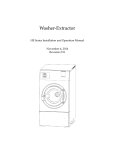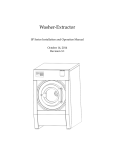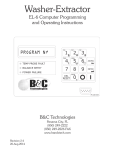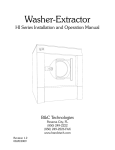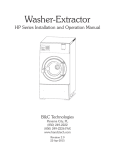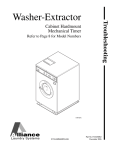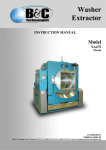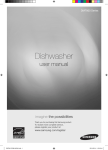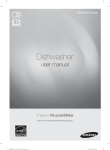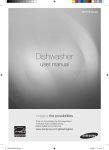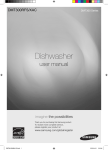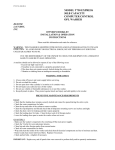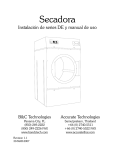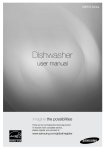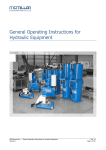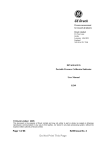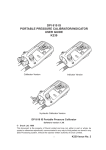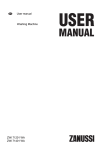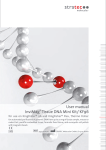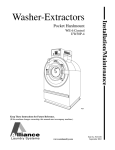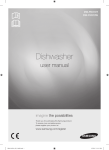Download SI Series Installation and Operation Manual
Transcript
Washer-Extractor SI Series Installation and Operation Manual 9-Sep-2013 Revision 2.20 Contents 1 Model Identification 1 2 Important Instructions 3 2.1 Before Attempting Repairs . . . . . . . . . . . . . . . . . . . . . . . . . . . . . . . . . . 3 2.2 Parts Ordering Information . . . . . . . . . . . . . . . . . . . . . . . . . . . . . . . . . 4 2.2.1 Nameplate Location . . . . . . . . . . . . . . . . . . . . . . . . . . . . . . . . . 4 2.3 Key Symbols . . . . . . . . . . . . . . . . . . . . . . . . . . . . . . . . . . . . . . . . . . 5 2.4 Safety Information . . . . . . . . . . . . . . . . . . . . . . . . . . . . . . . . . . . . . . 5 2.5 Installation and Operational Safety Instructions . . . . . . . . . . . . . . . . . . . . . 6 3 Introduction 7 3.1 Customer Service . . . . . . . . . . . . . . . . . . . . . . . . . . . . . . . . . . . . . . . 8 3.2 Replacement Parts . . . . . . . . . . . . . . . . . . . . . . . . . . . . . . . . . . . . . . 8 3.3 Theory of Operation . . . . . . . . . . . . . . . . . . . . . . . . . . . . . . . . . . . . . 8 4 General Specifications 10 5 Installation 12 5.1 Receiving Inspection . . . . . . . . . . . . . . . . . . . . . . . . . . . . . . . . . . . . . 12 5.2 Safety Checklist . . . . . . . . . . . . . . . . . . . . . . . . . . . . . . . . . . . . . . . . 12 5.2.1 Operator Safety . . . . . . . . . . . . . . . . . . . . . . . . . . . . . . . . . . . . 13 5.2.2 Safe Operation Environment . . . . . . . . . . . . . . . . . . . . . . . . . . . . 14 5.2.3 Environmental Conditions . . . . . . . . . . . . . . . . . . . . . . . . . . . . . 14 5.2.4 Machine Location . . . . . . . . . . . . . . . . . . . . . . . . . . . . . . . . . . . 15 5.2.5 Input and Output Services . . . . . . . . . . . . . . . . . . . . . . . . . . . . . . 15 i 6 5.2.6 Inverter Drive . . . . . . . . . . . . . . . . . . . . . . . . . . . . . . . . . . . . . 16 5.2.7 Machinery Misuse . . . . . . . . . . . . . . . . . . . . . . . . . . . . . . . . . . 16 5.3 Dimensional Clearances . . . . . . . . . . . . . . . . . . . . . . . . . . . . . . . . . . . 17 5.4 Machine Foundation . . . . . . . . . . . . . . . . . . . . . . . . . . . . . . . . . . . . . 17 5.4.1 Mounting Bolt Installation . . . . . . . . . . . . . . . . . . . . . . . . . . . . . . 18 5.5 Transportation Brackets . . . . . . . . . . . . . . . . . . . . . . . . . . . . . . . . . . . 19 5.6 Drain Installation . . . . . . . . . . . . . . . . . . . . . . . . . . . . . . . . . . . . . . . 19 5.7 Electrical Installation . . . . . . . . . . . . . . . . . . . . . . . . . . . . . . . . . . . . . 20 5.8 Water Connection . . . . . . . . . . . . . . . . . . . . . . . . . . . . . . . . . . . . . . . 22 5.9 Steam Connection . . . . . . . . . . . . . . . . . . . . . . . . . . . . . . . . . . . . . . . 23 5.10 Compressed Air Connection . . . . . . . . . . . . . . . . . . . . . . . . . . . . . . . . . 25 5.11 External Chemical Supplies . . . . . . . . . . . . . . . . . . . . . . . . . . . . . . . . . 25 5.11.1 Chemical Connection . . . . . . . . . . . . . . . . . . . . . . . . . . . . . . . . 26 5.11.2 Chemical Signal Connections . . . . . . . . . . . . . . . . . . . . . . . . . . . . 27 5.12 Optional Loading Chute Installation . . . . . . . . . . . . . . . . . . . . . . . . . . . . 27 5.12.1 Chute Up Switch Installation . . . . . . . . . . . . . . . . . . . . . . . . . . . . 28 5.13 Control Function Test . . . . . . . . . . . . . . . . . . . . . . . . . . . . . . . . . . . . . 28 Operation 32 6.1 Door Lock Operation . . . . . . . . . . . . . . . . . . . . . . . . . . . . . . . . . . . . . 32 6.1.1 Opening and Closing the Door . . . . . . . . . . . . . . . . . . . . . . . . . . . 32 6.1.2 Opening and Closing the Door with Hydraulic Assist Option . . . . . . . . . 32 6.1.3 Periodic Maintenance . . . . . . . . . . . . . . . . . . . . . . . . . . . . . . . . 33 6.2 Machine Loading . . . . . . . . . . . . . . . . . . . . . . . . . . . . . . . . . . . . . . . 33 6.3 Machine Loading with Optional Loading Chute . . . . . . . . . . . . . . . . . . . . . 33 6.4 Wash Program Execution . . . . . . . . . . . . . . . . . . . . . . . . . . . . . . . . . . . 35 6.4.1 End Step Condition: Level . . . . . . . . . . . . . . . . . . . . . . . . . . . . . . 37 6.4.2 End Step Condition: Temperature . . . . . . . . . . . . . . . . . . . . . . . . . 37 6.4.3 End Step Condition: Time . . . . . . . . . . . . . . . . . . . . . . . . . . . . . . 37 6.4.4 Single Step Execution . . . . . . . . . . . . . . . . . . . . . . . . . . . . . . . . 37 ii 7 8 9 6.4.5 Partial Program . . . . . . . . . . . . . . . . . . . . . . . . . . . . . . . . . . . . 38 6.4.6 Displaying the Current Program and Step . . . . . . . . . . . . . . . . . . . . . 38 6.4.7 Soak . . . . . . . . . . . . . . . . . . . . . . . . . . . . . . . . . . . . . . . . . . 38 6.4.8 Advance . . . . . . . . . . . . . . . . . . . . . . . . . . . . . . . . . . . . . . . . 38 6.4.9 Halting a Program . . . . . . . . . . . . . . . . . . . . . . . . . . . . . . . . . . 39 6.4.10 Water Level Refresh . . . . . . . . . . . . . . . . . . . . . . . . . . . . . . . . . 39 6.4.11 Unbalance . . . . . . . . . . . . . . . . . . . . . . . . . . . . . . . . . . . . . . . 39 6.4.12 Power Failure . . . . . . . . . . . . . . . . . . . . . . . . . . . . . . . . . . . . . 39 6.4.13 End of Program . . . . . . . . . . . . . . . . . . . . . . . . . . . . . . . . . . . . 39 6.4.14 Malfunction Alarms . . . . . . . . . . . . . . . . . . . . . . . . . . . . . . . . . 39 6.4.15 Maintenance Alarm . . . . . . . . . . . . . . . . . . . . . . . . . . . . . . . . . 41 Maintenance 42 7.1 Daily . . . . . . . . . . . . . . . . . . . . . . . . . . . . . . . . . . . . . . . . . . . . . . 42 7.1.1 Beginning of Day . . . . . . . . . . . . . . . . . . . . . . . . . . . . . . . . . . . 42 7.1.2 End of Day . . . . . . . . . . . . . . . . . . . . . . . . . . . . . . . . . . . . . . 43 7.2 Weekly . . . . . . . . . . . . . . . . . . . . . . . . . . . . . . . . . . . . . . . . . . . . . 43 7.3 Monthly . . . . . . . . . . . . . . . . . . . . . . . . . . . . . . . . . . . . . . . . . . . . 43 7.4 Quarterly . . . . . . . . . . . . . . . . . . . . . . . . . . . . . . . . . . . . . . . . . . . . 45 7.5 Care of Stainless Steel . . . . . . . . . . . . . . . . . . . . . . . . . . . . . . . . . . . . . 48 Service & Parts 50 8.1 Service . . . . . . . . . . . . . . . . . . . . . . . . . . . . . . . . . . . . . . . . . . . . . 50 8.2 Parts . . . . . . . . . . . . . . . . . . . . . . . . . . . . . . . . . . . . . . . . . . . . . . 50 Decommisioning 51 iii Chapter 1 Model Identification Information contained in this manual is for the following machines: SI-110 SI-135 SI-200 SI-275 SI-300 Refer to the SI Product Family chart on page 2 for details about the configuration and build of a particular machine. The Product Family Chart ”‘decodes”’ the model information as shown on the serial decal. 1 Figure 1.1: SI Product Family 2 Chapter 2 Important Instructions 2.1 Before Attempting Repairs Moving parts can cause serious injury or death. Before attempting repairs, follow proper shutdown procedures and remove power before commencement of service. Safety is of primary concern with any maintenance or repair operation. If you are in any way unsure of how to proceed with a repair or adjustment, consult this manual, a qualified maintenance technician, your local distributor, or the B&C Technologies Technical Service Department at 850-249-2222. Only trained and experienced personnel should attempt maintenance or repair work on this equipment. Follow all safety procedures including lock-out/tag-out procedures carefully. Ensure that any loose fitting clothing or jewelry is tucked in or not worn to avoid being pulled into the machine. Remember, the machine has no brain - you must use your own. Before attempting repairs, follow proper shutdown procedures and remove power before commencement of service. Never attempt to clean or service any area of the machine without removing power at the main disconnect. Read, follow, and obey these safety rules! The B&C Technologies Technical Service Department 3 is available to answer any questions you may have about the operation and servicing of your machine. Please call with any questions or concerns about the operation of your machine. 2.2 Parts Ordering Information If you require literature or spare parts, please contact your local distributor. If a local distributor is unavailable, you may contact B&C Technologies directly at (850) 249-2222 for the name of your nearest parts dealer. For technical assistance in the United States, contact B&C Technologies: (850) 249-2222 Phone (850) 249-2226 FAX [email protected] www.bandctech.com 2.2.1 Nameplate Location When contacting B&C Technologies about your equipment, please make note of the model and serial number, located on the nameplate as shown in figure 2.1. Figure 2.1: Serial Decal 4 2.3 Key Symbols Anyone operating or servicing this machine must follow the safety rules in this manual. Particular attention must be paid to the DANGER, WARNING, and CAUTION blocks which appear throughout the manual and shown in figures 2.2 on page 5. Figure 2.2: Key Symbols 2.4 Safety Information Installation Notice: For personal safety and for proper operation, the machine must be grounded in accordance with state and local codes and in the USA in accordance with the National Electric 5 Code, article 250-96. Elsewhere, the equipment should be grounded in accordance with ANSI/NFPA 70, or the Canadian Electrical Code, CSA C22.1. The ground connection must be to a proven earth ground, not to conduit or water pipes. 2.5 Installation and Operational Safety Instructions 1. Read all instructions prior to operating this equipment. 2. Ensure that the equipment is properly grounded before applying power and operation commences. 3. Do not allow children to play in or around or operate this equipment. 4. Check the operation of all safety interlocks at the start of every shift. If the interlocks do not stop the equipment immediately, the machine must be removed from service. Notify your immediate supervisor, and do not operate the machine. 5. Never attempt to service the machine while it is running. Never reach over, under, around, or behind any safety device, or into any area near moving parts or hot surfaces without shutting off power and allowing the machine to adequately cool. 6. Read, understand, and follow all safety instructions. Do not come close to moving parts and hot surfaces. Do not wear loose clothing, jewelry, neckties, or any other garment that could be come caught in the machine while operating or near the machine. 7. Only a qualified technician should attempt to service or repair the machine. 8. Do not install the machine in an area where it could be exposed to water or weather. 9. Do not alter or tamper with the control system. 10. Keep the interior and exterior of the machine clean of lint, dirt, dust and debris. 11. Always disconnect the electrical service from the machine before performing service. 12. This machine must be installed according to the installation instructions. All utility connections must comply with state and local codes and must be made by a licensed installer where required. 6 Chapter 3 Introduction The SI line is the industrial freestanding washer-extractor series of machines from B&C Technologies. It is an open pocket washer-extractor with a large door opening for easy and quick loading and unloading. It has been developed for the institutional and industrial market, and is suitable for commercial laundries, hotel, food processing plants, factories and other places where laundry might be processed. The design allows for top performance at lowest possible operation cost and investment. The flexible electronic control center ensures that maximum productivity is obtained. The SI series utilizes high quality material, such as 304 (18/8) stainless steel in vital parts in contact with the wash solution. It has a stainless steel cabinet for long life with easily removable panels. The key advantages of this series are the simplicity of the microprocessor and the electronic AC drive system, which utilizes only one motor. The system allows for washing and extraction at any speed and mechanical action to suit any textile fiber used today and tomorrow. A built in suspension system isolate objectionable vibrations and the high speed final extraction saves time and energy in the finishing operation. The main bearing is located outside the wash solution and will not be damaged, should the shell seals leak. The machine is provided with three V-seals, which are very reliable and will last for many years. The calculated life expectancy of the bearing is in excess of twenty years. The five compartment, side mounted supply dispenser for powder and liquid detergents are standard and the machine is designed to accept the connection of 8 additional external chemical lines and pumps. More chemical connections are available as an option. The SI series can be provided with tilt devices that can tilt the machine one or both ways. This option provides for easy loading and unloading and saves hard labor. The SI series is also prepared to accept the connection of water reuse systems. The tanks can be equipped with or without steam or electrical heat depending on installation and operation. The water reuse system is programmable by the machines control. 7 3.1 Customer Service For technical assistance: In the United States Phone: (850)-249-2222 FAX: (850) 249-2226 e-mail: [email protected] Web: www.bandctech.com 3.2 Replacement Parts In the event that literature or replacement parts are required, contact the local distributor of the equipment, or contact B&C Technologies at the above phone numbers/internet addresses. 3.3 Theory of Operation The B&C SI models use a single-speed motor to drive the cylinder via V-belts in all speeds. The cylinder is supported by two spherical roller bearings located in split pillow block housings made of cast steel. The motor is controlled by the computer control located in the front and the AC inverter drive located in the rear panel. Any speed can be programmed for any wash cycle. Some speed ranges are blocked out for programming due to safety reasons. These speed ranges are ones that the machine cannot operate at due to its spring or suspension resonance. This speed range is not important and normal speeds for wash or extraction are not within this range. Any wash speed in the range of 10-50 RPM and extraction speeds 150 to max RPM can be programmed. Further, any reversing action can be programmed. Normal reversing action is 16 seconds forward, pause for 4 seconds, and 16 seconds reverse. Any temperature between 70F to 200F (20-95C) can be programmed. Any water level in the range of the machine parameters can be programmed in centimeters. The computers will automatically provide safety levels for steam injections and door operations. Water entry into the machine is through electromagnetic water valves controlled by the computer. The computer also controls the drain, supply dispenser, any external liquid supplies, steam injection and any other vital functions of the wash program. The control also records cycles and data of importance that are used for maintenance purposes. The steam, if installed is injected in the bottom of the shell via a steam injector. The steam is controlled by a steam valve that is activated by the control. The cylinder is perforated, allowing water to pass through and drain from within during drain and extract steps. Lifting ribs inside the cylinder lift the load from the wash solution and allow the load to tumble and falling back into the solution when the load reaches the approximate 10-11 oclock or 1-2 oclock positions. This mechanical action removes soil from the fabric. Furthermore, 8 the lifters are perforated on the top so that water can cascade over the goods and wet them quickly. This reduces water consumption as water is picked up at the cylinders lowest point and lifted and splashed over the goods at the highest point as the cylinder rotates. A stainless steel door is provided for loading and unloading. A door lock system prevents operation of the machine when the door is open. The door is locked during operation utilizing an air cylinder and a manual latch for safety reasons. The door lock is provided with magnetic sensor to indicate that the machine is locked and provide for start of the machine when the door is closed and locked. The AC drive, brake unit, contactor, circuit overload protectors, input power supply connections, external supply connections, and control transformer are behind a cover of the rear of the machine. Pneumatic controls together with the air pressure regulator for the door seal are also located here. 9 Chapter 4 General Specifications 10 Figure 4.1: SI Series General Specifications 11 Chapter 5 Installation 5.1 Receiving Inspection Upon receipt of the equipment, visually inspect for shipping damage and note any damage with the carrier before signing the shipping receipt, or advise the carrier of the damage as soon as it is noted. If damage is discovered, a written claim must be filed with the carrier as soon as possible. Note: Warranty is VOID unless the equipment is installed according to instructions. The installation must comply with the minimum requirements listed in this manual. All national, state and local codes must be followed including but not limited to gas, electrical, plumbing and HVAC. Due to various requirements, statutory codes should be well understood before installation commences. Important: The machine should be transported and handled in an upright position. 5.2 Safety Checklist Before Initial start up of a B&C free-standing washer extractor perform the following safety check: 1. Make sure all electrical and plumbing connections have been made in accordance with applicable codes and regulations. 2. Make sure the machine is grounded electrically. 3. Make sure the machine has flexible water fill and drain connections of the correct size, length and type, with no kinks, and that they are securely attached and/or clamped. 4. Make sure the transport brackets have been removed. Before machine is placed in operation, the door safety interlock must be checked for proper operation as follows: 12 Before servicing any equipment, make certain it is disconnected from the electrical power source. Never allow operation of the machine when any safety device is malfunctioning. Never bypass safety devices. Never insert hands or objects into basket until it has completely stopped. Doing so could result in serious injury. 1. When the washer is energized electrically and in operation, the loading door must be locked in the closed position. Verify this by attempting to open the loading door when the machine is operating. If necessary, check the door safety interlock and sensors for proper operation. Consult the service manual, or call a qualified service technician if necessary. 2. When the washers loading door is open, it should not be possible to start the machine. Verify this by attempting to start the washer with the door open. Also, close the door without locking it and verify that it is not possible to start the machine with the door not locked. If necessary, check the door lock sensors for proper operation,. Consult the service manual, or call a qualified service technician. If additional information is required, contact your local distributor or call the manufacturer of the machine. • To provide personal safety and keep the machine in proper working order, follow all maintenance and safety procedures presented in this manual. If questions regarding safety arise. Contact the factory immediately. • Use factory authorized spare parts to avoid safety hazards. 5.2.1 Operator Safety To ensure the safety of machine operators the following maintenance checks must be performed daily. 1. Prior to operating the machine, verify that all warning signs are present and legible. Missing or illegible signs must be replaced immediately. Make certain that spares are available. 2. Check door interlock before starting operation of the machine, see safety check list. 3. Do not attempt to operate the machine if any of the following conditions are present: (a) The door does not remain securely locked during the entire cycle. (b) Excessively high water level is evident. (c) Machine is not connected to a properly grounded circuit. Do not bypass any safety devices in the machine. 13 Never operate the machine with a bypassed or disconnected out-of-balance switch. Operating the machine with severe out-of-balance loads could result in personal injury and serious equipment damage. Do not place volatile or flammable fluids in any machine. Do not clean the machine with volatile or flammable fluids such as acetone, lacquer thinners, enamel reducers, carbon tetrachloride, gasoline, benzene, naphtha, etc. Doing so could result in serious personal injury and/or damage to the machine. 5.2.2 Safe Operation Environment Safe operation requires an appropriate operating environment for both the operator and the machine. If questions regarding safety arise, contact the factory. 5.2.3 Environmental Conditions 1. Ambient temperature. Water in the machine will freeze at temperatures of 32F (0C) or below. Temperatures above 120 F (50C) will result in more frequent motor overheating and, in some cases, malfunction or premature damage to solid state devices that are used in the machines. Special cooling devices may be necessary. 2. Humidity. Relative humidity above 90% may cause the machines electronics or motors to malfunction or may trip the ground fault interrupter. Corrosion problems may occur on some metal components. If the relative humidity is below 30% belts and rubber hoses may eventually develop dry rot. This condition can result in hose leaks, which may cause hazards external to the machine in conjunction with adjacent electrical equipment. 3. Ventilation. The need for make-up air openings for such laundry room accessories as dryers , ironers, water heaters, etc. must be evaluated periodically. Louvers, screens, or other separating devices may reduce the available air opening significantly. 4. Radio Frequency Emissions. A filter is available for machines in installations where floor space is shared with equipment sensitive to radio frequency emissions. All machines that are shipped to CE countries are equipped with this filter and comply with the EMI regulations. 5. Elevation. If the machine is to be operated at elevations over 3280 feet (1000 meters) above sea level, pay special attention to water levels and electronic settings ( particularly temperature) or desired result may not be achieved. 6. Chemicals. Keep stainless steel surfaces free of chemical residues to avoid corrosion. 7. Water damage. Do not spray the machine with water. Short circuiting and serious damage may result. Repair immediately all seepage due to faulty gaskets, etc. 14 Replace all panels that are removed to perform service and maintenance procedures. Do not operate the machine with missing guards or with broken or missing parts. Do not bypass any safety devices. 5.2.4 Machine Location 1. Foundation. The concrete floor must be of sufficient strength and thickness to handle the floor loads generated by the machine at high extract speeds. 2. Service/ Maintenance Space. Provide sufficient space to allow comfortable performance of service procedures and routine maintenance. This is especially important in connection with machines equipped with AC inverter drives. Consult installation instructions for specific details. 5.2.5 Input and Output Services 1. Water pressure. Best performance will be realized if water is provided at a pressure of 30-85 psi (2.0-5.7 bar). Although the machine will function properly at lower pressure, increased fill time will occur. Water pressure higher than 120 psi (8.0 bar) may result in damage to machine plumbing. components failure (s) and personal injuries. 2. Air Pressure. Best performance will be realized if air is provided at a pressure of 80-100psi (5.4-6.7 bar). SI series machines will experience door seal and drain failure if compressed air service is interrupted. Regulators for the door seal and optional tilting should be set to a maximum of 15 PSI (1 bar) and 60 PSI (4 bar) respectively. 3. Optional Steam heating pressure. Best performance will be realized if steam pressure is provided at a pressure of 30-80 psi (2.0-5.4 bar). Steam pressure higher than 125 psi (8.5 bar) may result in damage to steam components and may cause personal injuries. For machines equipped with optional steam heat, install piping in accordance with approved commercial steam practices. Failure to install a steam filter may void the warranty. 4. Drainage System. Provide drain lines or troughs large enough to accommodate the total quantity of water that could be dumped if all machines on the site drained at the same time from the highest attainable level. If drain troughs are used, they should be covered to support light foot traffic 5. Power. For personal safety and for proper operation, the machine must be grounded in accordance with state and local codes. The ground connection must be to a proven earth ground, not to conduits or water pipes. An easy-access disconnect switch should be provided. Ensure that a ground wire from a proven earth ground is connected to the ground lug in the electrical junction box on this machine. Without proper grounding personal injury from electrical shock could occur and machine malfunctions may be evident. Computer-controlled machines must have a proper ground to prevent computer malfunctions. 15 Always disconnect power and water supplies before a service technician performs any service procedure. Where applicable, steam and/or compressed air supplies should also be disconnected before service is performed. 5.2.6 Inverter Drive Machines equipped with AC drives require special attention with regard to the operating environment. 1. An especially dusty or linty environment will require more frequent cleaning of the AC drive cooling fan filter and of the AC drive itself. 2. Power line fluctuations from sources such as an uninterruptible power supplies (UPS) can adversely affect machines equipped with the AC drive. Proper suppression devices should be utilized on the incoming power to the machine to avoid problems. 3. A clean power supply free from voltage spikes and surges is absolutely essential for machines equipped with the AC drive. Nonlinear inconsistencies (peaks and valleys) in the power can cause the AC drive to generate nuisance errors. If voltage is above 230V for 200 V installations or above 460V for 400V installations, a buck/boost transformer is recommended. If voltage is above 240V or 480V, a buck/boost transformer is required unless the factory advises differently. 4. Sufficient space to perform service procedures and routine preventive maintenance is especially important for machines equipped with AC drives. 5.2.7 Machinery Misuse Even though this machine is an atmospheric vessel, never use it for any purpose other than washing fabrics. 1. Never wash petroleum-soaked rags in the machine. This could result in an explosion. 2. Never wash machine parts or automotive parts in the machine. This could result in serious damage to the wash cylinder. 3. Never stone wash in the machine. It could wear the wash cylinder and serious damage might occur to the machine. 4. Never use the machine for dyeing nor with harsh chemicals that can cause corrosion and other health hazards. 5. Never allow children to play on or around this machine. Death or serious injury can result if children become trapped in the machine. Do not leave children unattended while the machine door is open. These cautions apply to animals as well. 16 5.3 Dimensional Clearances When installing the washer-extractor, it is important to allow adequate clearance on all sides of the machine. When multiple machines are installed, it is important to allow for the specified minimum clearances between machines. Figures 5.1 and 5.1 show recommended minimum clearances for the various freestanding models. Note: The dimensions are approximate and subject to normal manufacturing tolerances. If exact dimensions are required for construction purposes, request certified drawings from the factory. We reserve the right to make changes at any time without notice. Figure 5.1: Minimum Service Clearances Table 5.1: Minimum Service Clearnances UNITS UNITS SI Series SI Series Tilt Metric US (A) Minimum rear clearance mm in 760 30 760 30 (B) Minimum clearance between machine and wall mm in 455 18 455 18 (C) Minimum clearance between machines mm in 455 18 455 18 (D) Minimum front clearance mm in 850 33 1220 48 5.4 Machine Foundation Thoroughness of details must be stressed with all foundation work to insure a stable unit installation, eliminating possibilities of excessive vibrations during extraction. 17 For a successful installation, a smooth level surface, so that the entire base of the machine is supported and rests on the mounting surface, is absolutely requried. Note: Do not support the machine on only four points. Note: Freestanding washer-extractors do not require anchoring bolts unless specified by state or local codes. However it is always recommended that the machines be anchored. Special care must be taken when machines are installed on an upper floor. Make sure that the floors are designed to carry the static and dynamic loads of the machines. Further vibrations should be taken into consideration so that the machine does not create vibrations in the building. Static and dynamic loads on the floor or foundation are shown in the figure 5.2 on page 18. This table can be used as reference when designing floors and foundations. Table 5.2: Floor Load Data SI-110 SI-110 TILT SI-135 SI-135 TILT SI-200 SI-200 TILT SI-275 SI-275 TILT 5.4.1 Static floor load kN lbs 15 3300 17 3900 22.3 4900 24.9 5600 26.8 5900 30.25 6800 47.7 10500 51.3 11300 Static pressure kN/m2 lbs-ft2 5.7 117 6.5 138.5 7.4 152 8.3 173.9 7.13 149 7.13 149 11.96 248 13.05 267 Dynamic floor load kN lbs 1.5 330 1.5 330 1.5 330 1.5 330 2.45 540 2.45 540 4.09 900 4.09 900 Max dynamic load kN lbs 1.5 330 1.5 330 1.5 330 1.5 330 2.45 540 2.45 540 4.09 900 4.09 900 Dynamic pressure kN/m2 lbs-ft2 0.57 11.7 0.57 11.7 0.5 10.25 0.5 10.25 0.88 18.3 0.88 18.3 1.04 21.3 1.04 21.3 Mounting Bolt Installation All B&C washer-extractors should be secured by the use of machinery anchor bolts. High strength machinery anchors should be embedded in 3500 psi (24000 N/m2) reinforced concrete. For detailed information regarding the machine anchor bolt, see the instructions included with the anchor bolts themselves. The information provided is just an example. Ensure that the concrete is fully cured before proceeding. Place the machine adjacent to the foundation. Do not attempt to move it by pushing on the sides. 1. Remove the wood skid by unscrewing the carriage bolts holding it to the bottom frame of the machine. 2. Carefully place the machine over the anchor bolts. Raise and level it 1/2 inch above the floor on four points, using spacers that can be removed. 3. Fill the spaces between the machine base and floor with machinery grout. Grout completely under all frame members. Remove front panel and rear panel to gain access to all frame members. Force grout under the machine base until all voids are filled. 18 Figure 5.2: Typical Machinery Anchor Installation 4. Remove the spacers carefully, allowing the machine to settle into the wet grout. 5. Attached the mounting bolt washers and lock nuts to the anchor bolts after the grout has hardened. Tighten the lock nuts by even increments-one after the other-until all are tightened evenly and the machine is fastened securely to the floor. The nuts should be tightened in a diagonal fashion, which will help ensure equal tension at all anchor points. 6. Remove the transportation brackets which secure the moving components of the machine during shipping. Refer to figure 5.3 on page 20 for typical locations. 5.5 Transportation Brackets Remove both front and rear transportation brackets, as well as tilting transportation brackets. Failure to remove shipping brackets before operation of the SI series will void your warranty. Inspect the machine carefully to ensure that all transportation brackets are removed. All transportation brackets are painted red for easy identification. 5.6 Drain Installation A drain system of adequate capacity is essential to the machine performance. Ideally the water should empty through a 4 inch vented pipe directly into a sump or floor drain. See figure 5.4 on 21. A flexible connection must be made to a vented drain system to prevent an airlock or siphon effect. If proper drain size is not available or practical, a surge tank is required. A surge tank in 19 Figure 5.3: Typical Machinery Transportation Bracket Location conjunction with a sump pump should be used when gravity drainage is not possible, such as in below-ground-level installations. Before any deviation from specified installation procedures is attempted, the customer or installer should contact the manufacturer. Increasing the drain hose length, installing elbows, or causing bends will decrease drain flow rate and increase drain time, impairing machine performance. If the drain arrangement is inadequate, the machine will not extract and will not discharge water properly. 5.7 Electrical Installation The AC drive requires a clean power supply free from voltage spikes and surges. A voltage monitor should be used to check incoming power. The customers local power company may provide such a monitor. The AC drive provides for an internal circuit breaker. A separate circuit breaker governs the control circuit. If input voltage measures above 230V for a 200V class drive or above 460V for a 400V class drive, either ask the power company if their representative can lower the voltage or install a bucking 20 Figure 5.4: Drain System Information This machine must be installed, adjusted, and serviced by a qualified electrical maintenance personnel familiar with the construction and operation of this type of machinery. They must also be familiar with the potential hazards involved. If this warning is not observed, personal injury or equipment damage resulting in voiding the warranty may result. transformer kit available from the manufacturer. Voltages above 250V and 490V require additional measures. Contact the distributor or the manufacturer for assistance. Table 5.3: Electrical Service Requirements 200-240V Machine Max Amps Breaker SI-110 21 30 SI-135 32 40 SI-200 58 60 SI-275 79 80 SI-300 89 90 Wire Size 10ga / 4mm 8ga / 10mm 6ga / 16mm 6ga / 16mm 6ga / 16mm 380-480V Max Amps Breaker 11 15 16 20 29 30 39 40 45 50 Wire Size 10ga / 4mm 10ga / 4mm 8ga / 10mm 8ga / 10mm 8ga / 10mm Note: Do not use phase adders (roto-phase) on inverter driven equipment! Note: Wire sizes shown are for copper, THHN, 90 conductor per NEC article 310 (USA). The machine should be connected to an individual branch circuit not shared with lighting or other If controlling the AC drive with a parameter unit, the machines computer and its safety features are bypassed. This could allow the basket to rotate at high speeds with the door open. When using a parameter unit to control the AC drive, a large sign should be placed on the front of the machine warning people of the imminent danger. 21 Never touch terminals or components of the AC drive unless power is disconnected and the ”‘CHARGE”’ indicator LED is off. The AC drive retains potential deadly voltage for some time after the power is disconnected. There are no userserviceable parts inside the AC drive. Tampering with the drive will void the warranty. Dangerous voltage are present in the electrical control boxes and at the motor terminals. Only qualified personnel familiar with electrical test procedures, test equipment, and safety precautions should attempt adjustments and troubleshooting. Disconnect power from the machine before removing the control box cover, and before attempting any service procedures. equipment. Because this is a vibrating machine, the use of SO cable or similar, with a twist-lock plug, to connect the machine to main power is recommended. A shielded liquid tight or approved flexible conduit with proper conductor of correct size installed in accordance with National Electric Code (USA) or other applicable codes is also acceptable. The connection must be made by a qualified electrician using the wiring diagram provided with the machine. See the Electrical Connection data Chart for correct wire sizes. For personal safety and for proper operation, the machine must be grounded in accordance with state and local codes and in the USA in accordance with the National Electric Code, article 250-96. The ground connection must be to a proven earth ground, not to conduit or water pipes. Do not connect the ground to the neutral (N) leg at the terminal strip (if so equipped). If a DELTA supply system is used, the high leg should be connected to T, since control voltage is derived from R and S. Insure that the control transformer taps are connected in accordance with the incoming line voltage. Verify connections as shown on the schematic with each machine. 5.8 Water Connection Individual hot and cold plumbing lines with individual shut-off valves must be available to the machine. Hot water should be minimum of 160F (70C). If lower temperature water is used the machine can be equipped for steam heating to heat the wash solution to desired temperature. Best performance will be realized if water is provided at a pressure of 30-85 psi (2-7 Bar). Although the machine will function properly at lower pressures, increased fill times will occur. If the fill time exceeds 9 minutes, the EL6 control will display a WDT LEVEL EXP (watch dog timer) alarm, indicating that the machine did not fill quickly enough. This watch dog timer is programmable – see the EL6 Programming Manual, included with the machine, for further details. Flush the water system for at least two minutes prior to initial use. Use flexible hoses and install separate screen filters in the lines to keep rust and other foreign 22 particles out of the solenoid valves. Hang the hoses in a large loop. Do not allow the hoses to kink. The water connections to the machine should be supplied by a hot and cold water line of least the sizes shown in table 5.4 on page 23. Refer to table 5.5 and 5.6 on page 23 for details on individual machine requirements. Table 5.4: Water Connection Detail # OF MACHINES 1 2 3 4 5 6 SUPPLY LINE PIPE SIZES SI-110 SI-135 SI-200 DN Inch DN Inch DN Inch 25 1 32 1-1/4 32 1-1/4 25 1 32 1-1/4 32 1-1/4 40 1-1/2 50 2 50 2 40 1-1/2 50 2 50 2 50 2 63 2-1/2 63 2-1/2 50 2 63 2-1/2 63 2-1/2 SI-275 DN Inch 40 1-1/2 40 1-1/2 50 2 50 2 63 2-1/2 63 2-1/2 To avoid eventual water hammer in the water line, suitable devices to reduce the water hammer should be installed. Table 5.5: SI-110 Water Requirements Connection Size US Metric 1” DN 25 Water Line Pressure PSI Bar 30-75 2-5 Max Temp F C 200 93 Flow Rate (@45PSI/3Bar) gal/min liter/min 30 113 Minimum Supply Line Size US Metric 1-1/4 DN 32 Max Operating Pressure US Metric 125 PSI 8 Bar Table 5.6: SI-135 / SI-200 / SI-275 / SI-300 Water Requirements Connection Size US Metric 1-1/4” DN 32 5.9 Water Line Pressure PSI Bar 30-75 2-5 Max Temp F C 200 93 Flow Rate (@45PSI/3Bar) gal/min liter/min 37 140 Minimum Supply Line Size US Metric 1-1/2 DN 38 Max Operating Pressure US Metric 125 PSI 8 Bar Steam Connection For machines equipped with optional steam heat, install piping in accordance with approved commercial steam practices. Steam requirements are shown in the table 5.7 on page 24. Failure to install a steam filter/trap may void the warranty. 23 Never touch internal or external steam pipes, connections, or components. These surfaces can be extremely hot and will cause severe burns. The steam must be turned off and the pipe, connections, and components allowed to cool before the pipe can be touched. Table 5.7: Steam Service Consumption Data MODEL Units SI-110 STEAM INLET and CONSUMPTION: Steam inlet size DN in 20 3/4 Required steam to heat bath 10F (6C)LOW kg lbs 3.15 7 Required steam to heat bath 10F (6C)HIGH kg lbs 4.77 10.5 Average Steam consumption per cycle kg lbs 72 158 MODEL Units STEAM INLET and CONSUMPTION: Steam inlet size DN in Required steam to heat bath 10F (6C)LOW kg lbs Required steam to heat bath 10F (6C)HIGH kg lbs Average Steam consumption per cycle kg lbs MODEL Units STEAM INLET and CONSUMPTION: Steam inlet size DN in Required steam to heat bath 10F (6C)LOW kg lbs Required steam to heat bath 10F (6C)HIGH kg lbs Average Steam consumption per cycle kg lbs SI-135 20 3.8 5.8 88 3/4 8.4 12.76 194 SI-200 25 5 7.7 117 1 11 16.9 194 MODEL Units SI-275 STEAM INLET and CONSUMPTION: Steam inlet size DN in 25 1 Required steam to heat bath 10F (6C)LOW kg lbs 5.25 11.5 Required steam to heat bath 10F (6C)HIGH kg lbs 7.95 17.5 Average Steam consumption per cycle kg lbs 120 260 24 5.10 Compressed Air Connection Best performance will be realized if air is provided at a pressure of 80-100psi (5.4-6.7 bar). SI Series machines will experience door seal and drain failure if compressed air service is interrupted. Ensure the provided air is filtered and dry. Wet and/or dirty air will cause rapid deterioration of internal components and void your warranty on these parts. Install a compressed air dryer to prevent water build up in the airlines. Make sure to use best practice when installing air lines so that water does not damage internal air components - the machine should not be the low point in the air path. Install an inline air filter on each machine to reduce contamination (B&C part number 270-324 or purchase locally). Refer to figure 5.5 on page 25. Figure 5.5: Compressed Air Connection Detail 5.11 External Chemical Supplies The following procedures must be observed when connecting any chemical injector to the washerextractor. See figure 5.6 on 26 for a typical supply injection system setup. Undiluted chemicals dripping can damage the machine. Therefore, all chemical supply dispenser pumps should be mounted below the washers injection point. All dispenser tubing should also run below the injection point. Loops do not prevent drips if these instructions are not followed. Failure to follow these instructions could damage the machine and void the warranty. Wear Eye and hand protection when handling chemicals. Always avoid direct contact with raw chemicals. Read the manufacturers directions for accidental contact before handling chemicals. Ensure that an eye-rinse facility and an emergency shower are within easy reach. Check at regular intervals for chemical leaks. 25 Figure 5.6: External Chemical Supply Connection Detail 5.11.1 Chemical Connection The supply compartment on the B&C SI models is located on the left front side of the machine. Supply cups can be accessed by opening the dispenser lid. The supply cups can be removed and filled as desired. Supply compartments are numbered 1,2,3,4 and 5 from the left to the right. The five cup supply dispenser will flush each cup when Detergent 1 through Detergent 5 is programmed. The programmed chemical signal also appears as a 24VAC signal at the external chemical terminal strip for the duration of each programmed signal. External supply connections for the B&C SI washer-extractors are located on top of the supply dispenser. Hose connections should be made via the strain relief. 1. Remove plugs from base. See figure. Plugs are assembled inside the tubing ring. 2. Install strain relief, included in the seal nut. 3. Insert tubes through base. Do not remove cups. Tube should extend into the plastic cup, with the exception of the softener tube, which should be routed to the outside of the cup. 4. Tighten the seal nut to prevent tubing from escaping the assembly. See figure 5.7 on page 27. 26 Figure 5.7: SI Series external chemical injection points Attempting to obtain power from the machine terminals may damage the machine circuit and/or the chemical injection system. Consult the chemical injection supply system instructions for operational details. 5.11.2 Chemical Signal Connections Connection terminals are located in the rear control box for output signals to the chemicals injection supply pump. Refer to figure 5.8 on page 28. Terminals SUPPLY 1 through SUPPLY 8 provide signals for external chemical supply pumps. The signal is a maximum of 1 amp at 24V 50/60Hz. Do not attempt to increase circuit breaker rating as this will cause damage to the washer-extractor circuitry and void the warranty. Any injection system pump, which requires 24-220V AC must be powered by a separate external power source. 5.12 Optional Loading Chute Installation Refer to figure 5.9 on page 29. NOTE: It is highly recommended that the bearing housings for the chute be welded in place • Safely raise Chute above machine until the 4 mounting bolts are aligned and bolts can be 27 Figure 5.8: External Chemical Supply Terminal Block Detail inserted and tightened. • Connect Hydraulic rams • Temporarily install Chute Up Switch to operated the chute • Apply electrical and air to machine • Operate the chute, using the maintenance switch to make sure the safety locks properly engage freely • Use the pendant to lower the chute, CHUTE ENABLE and LOAD, ensure safety locks disengage freely • Adjust safety locks until chute operates properly • When properly aligned remove Chute Up Switch and weld in place • Re-install Chute Up Switch 5.12.1 Chute Up Switch Installation NOTE: Chute must me in the full up position Install mounting bracket and adjust switch so that half the length of the plunger is depressed. Refer to figure 5.10 on page 30. 5.13 Control Function Test The machine should be cleaned after the installation is complete. A function test should then be executed on the unloaded machine as follows: 28 Figure 5.9: Loading Chute Installation 29 Figure 5.10: Loading Chute Up Switch Installation 30 1. Check the proper supply for such characteristics as correct voltage, phase, and cycles to be certain they are correct for the machine. 2. Open manual shut-off water valves to the machine. 3. Press Emergency Stop button. 4. Apply power to the machine. 5. Release the Emergency button. 6. Check the door interlock before starting the machine. (a) Attempt to start the machine with the door open. The machine should not start with the door open. (b) Close the door without locking it and attempt to start the machine. The washer should not start with the door unlocked. (c) Close and lock the door and start a cycle. Attempt to open the door while the cycle is in progress. The door should not open. If the door lock and interlock are not functioning properly, call a service technician. 7. For testing, select program 30 by pressing key 3 and key 0 on the keypad. Then press ENTER followed by the START key. Run the complete program, checking operation of water inlet valves, drain, and extract functions. Program 30 is a test program that goes through most machine functions. Please note that the Spin 99 routine is designed to fail balance. Simply advance the program to the Spin 3 cycle after balance fails (use the appropriately named ADVANCE key). Refer to the EL6 Stock Program Listing that came with the machine for further details on the test program. 8. Cylinder rotation must be counter-clockwise in the extract step. If rotation is not correct, disconnect the power to the machine. A qualified technician must reverse any two leads between the AC drive and the motor. See figure 5.11 on page 31. Figure 5.11: Inverter Drive to Motor Detail 31 Chapter 6 Operation 6.1 Door Lock Operation The lock system uses a combination pushbutton / locking bar style mechanism which differentiates it from any other door lock in the industry. This design was developed as a result of analyzing the shortcomings of other door lock mechanisms on the market. It hence has many fundamental safety and mechanical advantages. 6.1.1 Opening and Closing the Door To open the door the machine must not be running a wash program – ”‘Program n.”’ should be displayed on the EL6. Press the unlock button, located on the top of the door lock box, and rotate the locking bar counter-clockwise until vertical. The door is now free to open. To close and lock the door, press the door unlock button, close the door, realease the button and rotate the locking bar clockwise until horizontal. When a wash program is started, the door lock is securely disabled so that the door cannot be accidentally opened. 6.1.2 Opening and Closing the Door with Hydraulic Assist Option To open the door the machine must not be running a wash program – ”‘Program n.”’ should be displayed on the EL6. Press either the Door Open or the Door Close button on the control pendant (located on the left front of the machine, just below the control) depending upon the operation required. Ensure that all personnel are standing clear of the door while it is in operation and moving to the fully open or fully closed position. The hydraulic system is adjusted at the factory to provide enough force to rotate the door, however, caution must be used during operation. 32 6.1.3 Periodic Maintenance • The door should be tested every day for safe operation by trying to start a program with the door open. If the machine will begin operation in this state it should immediately be removed from service, locked out, and a qualified service technician called to repair it. • If the door lock is malfunctioning in any way, the machine should immediately be removed from service, locked out, and a qualified service technician called to repair it. • The door lock pin and handle hinge should be lubricated with ”‘silicon spray lube”’ monthly. This product is available at almost any auto parts store. This procedure does not require any disassembly. • The door locking bar bushing should be checked for wear and damage monthly. It should be replaced when it is worn. The bar should only rotate and not move in or out relative to the front of the machine. 6.2 Machine Loading Proper loading of your SI series washer-extractor is a great factor in determining both the performance and longevity of your investment. Small loads are wasteful on many levels: 1. Small loads waste water, chemicals, electricity, and most expensively, time. Running your machine at lower than its rated capacity costs significant time and money. 2. Small loads cause more wear and tear on the machine. Small loads are very difficult to balance properly, and will cause excessive vibration during extract. These vibrations mean that bearing loads are higher, reducing the life of the main bearings. The extra vibrations also tend to cause other fasteners on the machine to loosen over time, causing premature wearing and more frequent service. 3. Smaller loads are not easier for the machine to handle - quite the opposite, they are more difficult on the entire machine. When the machine is under loaded, it causes greater stress on the inverter drive, belts, and motor, leading to reduced life of these expensive components. Refer to table 6.1 on page 34 for proper loading weights. If a scale isnt available, fill the machine up with goods to be laundered. Do not attempt to ”‘stuff”’ the machine full, but ensure that there is no gap at the top of the cylinder. 6.3 Machine Loading with Optional Loading Chute Refer to figure 6.1 on page 34 for pendant details. 33 Table 6.1: Proper Load Sizing Dry Weight Capacity Model Capacity SI-110 110 lb 50 kg SI-135 135 lb 61 kg SI-200 200 lb 91 kg SI-275 275 lb 125 kg SI-300 300 lb 136 kg Figure 6.1: Chute Pendant Control 34 • Home Position - Machine is level, Chute is in the up position and Door is closed (this is the starting position for any operator function). • Chute Enable - Tells the machine to lower the Chute when Load switch is selected • Chute Disable - Chute will stay locked in the up position when Load/Unload is selected • Load - When Chute Enable is selected, Starts the loading operation, door opens, Chute move down, Machine tilts back and start to jog automatically, and the water valve can be operated • Load - When Chute disable is selected, The door is opens, machine will tilt, and Jog buttons are enabled on pendant • Unload - When Chute Enable is selected the door will automatically open, the machine will tilt forward and the Jog buttons are enabled • Unload - When Chute Disable is selected, the door will automatically open, the machine will tilt forward and the Jog buttons are enabled NOTE: The machine must be in HOME position before switching from Enable to Disable or Disable to Enable. Home is always the starting position of any operation (Switching between Unload and Load is allowed). NOTE: Anytime there is a power loss or E-STOP is pressed the Safety Locks will automatically attempt to go to the Locked position. If they fail to unlock upon restoration of power, use the Maintenance Switch located in the rear of the machine. Refer to figure 6.2 on page 36 for maintenance switch details. WARNING! Chute up switch is for MAINTENCE ONLY! NOTE: Switch is located inside the electrical panel Move Home switch to Home on pendant. Activating the Maintenance switch will unlock the Safety locks and move the Chute to the full up position. 6.4 Wash Program Execution After power is applied to the machine, and the internal diagnostics are complete, the machine is ready for a program to be chosen. The display will show: PROGRAM N. Using the keypad, type the number of the program you wish to run followed by the ENTER key. Standard programs are outlined in the EL6 stock program list, included with the machine. The display will change to show the fist cycle of the selected program: 35 Figure 6.2: Chute Maintenance Switch 36 PRWH1 EXECUT.? press START to execute the program, or RESET to return to program selection. While the program is executing, the display shows the current segment of the program, and the ending condition of the segment. See the following examples: 6.4.1 End Step Condition: Level If the end requirement of the segment (step) is a particular water level, the display will show: RINSE1 LVL=cm12 cm12 is the actual water level in the machine (12 centimeters). Pressing the LEVEL key shows, for 3 seconds, the required value to advance. If INC or DEC is pressed, you can temporarily modify the value for the current step. Pressing TEMP allows you to see the current temperature of the water. Pressing the TIME key shows the watch dog timer (WDT) value for the current step. 6.4.2 End Step Condition: Temperature If the end condition of the segment is a temperature, the display will show: WASH3 TEMP=35C where 35C is the actual temperature of the wash solution. By pressing TEMP the display will change, for 3 seconds, show the required step temperature for advance. Pressing INC or DEC allows modification of the value for the step. Pressing LEVEL allows you to see the current water level. Pressing the TIME key shows the watch dog timer (WDT) value for the current step. 6.4.3 End Step Condition: Time If the end of the step calls for a time to elapse, the display shows: RINSE1 T=2m 30s In this case, the display shows the time left in the step. INC and DEC allow you to add or subtract minutes for the current cycle. TEMP allows you to view the current water temperature, and LEVEL shows the current water level. Note: During heating, fill and drain phases, the WDT (watch dog timer) is activated. If the phase does not complete before the timer expires, an alarm will be displayed indicating that the particular phase did not complete within the time allowed. 6.4.4 Single Step Execution A single step or cycle of a wash program can be executed. At the main prompt, enter zero for the program number. For two seconds, the display changes to: 37 SINGLE CYCLE Then quickly to: PREWASH=? Now, using the INC and DEC keys, you may choose the cycle you wish to run (PREWASH, WASH, RINSE, SPIN, UNROLL). When you have selected the cycle type, press ENTER and select the cycle number. Confirm by pressing ENTER. The display changes to: PRWH1 EXECUT.? Pressing the START key will execute the cycle you chose (Prewash1 in this example). 6.4.5 Partial Program A program can be started from the beginning, or at any subsequent cycle. After selecting the program you wish to execute, the display will show: PRWH1 EXECUT.? Instead of pressing START to execute the program, press the ADVANCE key. The cycles within the program will be displayed incrementally. Choose the point at which you would like to begin, and press the START key. The machine will begin operation from this point. 6.4.6 Displaying the Current Program and Step While the machine is in operation, pressing then ENTER key will cause the display to show the current program number and step. PRG 1 STP 3 6.4.7 Soak You can insert a pause at any point of the wash program with the exception of distribution and spin. To do so, simply press the PAUSE key. The display will begin showing a time, counting up as long as the machine remains paused. Pressing the START key will restart the program at the point it was paused. As long as the machine is paused, all other WDT (watch dog timers) are paused as well. 6.4.8 Advance While any program is running, you can end the current step and advance to the next one by pressing the ADVAN key. If the key is pressed during a spin, the spin will be aborted, and the standard spin slow down time will be activated. It is possible to disable the advance function. 38 6.4.9 Halting a Program At any time during the execution of the wash program, the running program can be terminated by pressing the STOP key. 6.4.10 Water Level Refresh While a program is running, if the water level drops to a level which is 3cm below the target level, cold water will automatically be added to replenish the level. 6.4.11 Unbalance If the load is excessively out of balance, the spin routine will stop and a redistribution of the goods will take place. If three consecutive out of balances occur, the machine will end the program. After the first unbalance, the balance indicator will light on the control panel and remain illuminated until a new program is started. The balance indicator light does not necessarily indicate a problem, but that one or more retries was required. 6.4.12 Power Failure If the power fails during execution of a program, and is of less than one second, it is ignored. If the failure is longer than one second, the machine stops. Upon restoration of mains power, the display shows CYCLE CONTINUE? and the power failure indicator illuminates on the front panel. If you wish to restart the program at the point in which power failed, press the START key. At this point, the program restarts at the point of power failure and the power failure indicator turns off. If you wish to cancel the program, simply press the RESET key. This function is not active while a single cycle is running. 6.4.13 End of Program When a program has completed, the message PLEASE WAIT is displayed and the buzzer sounds. The buzzer can be silenced by pressing the RESET key. If the temperature or water level are out of too high, the display shows the offending value and for safety reasons, the door cannot be opened until the temperature inside the cylinder is cool enough, or there is no more water. 6.4.14 Malfunction Alarms The state of the water temperature and water levels are constantly monitored to prevent functioning problems with these devices. Watch Dog Timers (WDT) are used to prevent cycle failure when 39 temperatures, fills, drains, and levels dont meet programmed values. In the event of a program fault, the buzzer sounds and the display changes to show the fault: LEVEL FAULT Indicates a problem with the level sensing system. This could be a loose or cracked water level tube, the level sensor, or the level sensing circuit. As long as the system detects a problem with the level sensing system, the machine will be inoperable. The buzzer can be disabled with the RESET. Refer to the EL6 Manual for possible remedies. TEMP FAULT Indicates a problem with the temperature sensing circuitry, temperature probe, or wiring. The machine continues to function, although auxiliary heating (if equipped) is disabled. The Temperature fault indicator on the control panel will be illuminated. WDT TEMP EXP Indicates the programmed temperature was not reached within the allotted time. The most common cause is a malfunctioning auxiliary heating system. A short WDT time and very cold water can also cause this problem. Pressing the START key will cancel the alarm and allow the program to continue. WDT LEVEL EXP eached within the allotted time. The most common causes: During Fill • Faulty water inlet valve • Low or no water pressure • Faulty drain valve • Problem with water level tube Pressing START will continue the program, while RESET will cancel the program. During Drain • Drain valve blocked • Drain hose blocked • Faulty Drain Valve Pressing START will continue the program, while RESET to end the program. OVERLOAD! Indicates a possible fault with the inverter drive. Contact a qualified service technician. 40 OPEN DOOR Indicates the door is not closed properly. This fault disables the machine until cleared, and aborts a program if active. Press RESET to clear the fault. LEVEL=cm4 Indicates a water level of greater than 2cm a the onset of spin or at cycle end. The machine will resume the spin or unlock the door when the level falls below the threshold. Press RESET to abort the cycle. Can also indicate a problem with the EL6 water level system. See the EL6 manual for additional remedies. 6.4.15 Maintenance Alarm After 450 wash programs have completed, the control will call for maintenance: MAINTENANCE The message appears at the start of a program, and is repeated at the beginning of each wash program until reset (see function 217 in the EL6 Programming and Operation Manual for full details). Before resetting the alarm, PERFORM ROUTINE MAINTENANCE AS OUTLINED ELSEWHERE IN THIS MANUAL. For further information regarding access functions and programming, see the EL-6 Computer Programming and Operating Instructions manual, included with the machine or from the B&C Technologies website: www.bandctech.com. 41 Chapter 7 Maintenance Routine maintenance maximizes operating efficiency and minimizes downtime. The maintenance procedures described below will prolong the life of the machine and help prevent accidents. Daily, weekly, monthly, and quarterly checklist are provided at the end of this section. Laminate the checklists to preserve them for repeated copying. Operators and technicians are encouraged to add checks specific to their machines particular application. When possible, space is provided on the checklists for this purpose. The following maintenance procedures must be performed regularly at the required intervals. 7.1 7.1.1 Daily Beginning of Day 1. Inspect water inlet valve hose connections on the back of the machine for leaks. 2. Inspect steam hose connections for leaks, where applicable. 3. Verify that insulation is intact on all external wires and that all connections are secured. If bare wire is evident, call a service technician. 4. Check door interlock before starting operation: (a) Attempt to start the washer with the door open. The washer should not start with the door open. Replace all panels that are removed to perform service and maintenance procedures. Do not operate the machine with missing guards or with broken or missing parts. Do not bypass any safety devices. 42 (b) Close the door without locking it and attempt to start the machine. The machine should not start with the door open. (c) Close and lock the door and start a cycle. Attempt to open the door while the cycle is in progress. The door should not open. If manual latch is moved out of position the machine should stop. If the door lock and interlock are not functioning properly, call a service technician. 7.1.2 End of Day 1. Clean the door gasket of residual detergent and foreign matters. 2. Clean the automatic supply dispenser and the lid inside and out with mild detergent. Rinse with clean water. 3. Clean the washers top, front and side panels with mild detergent. Rinse with clean water. 4. Leave loading door open at the end of each day to allow moisture to evaporate. NOTE: Leave loading door open at end of each complete cycle to allow moisture to evaporate. Unload the machine promptly after each completed cycle to prevent moisture build up. 7.2 Weekly 1. Check the machine for leaks. (a) Start an unloaded cycle to fill the machine. (b) Verify that door and door gasket do not leak. (c) Verify that the drain valve is operating. If water does not leak out during the prewash segment, drain valve is closed and functioning properly. 2. Clean the AC drive box air filters. (a) Snap off the external plastic cover which contains the filter. Remove the foam filter from the cover. (b) Wash the filter in a mild soap solution or vacuum it clean. Replace if damaged. Operating the machine without filter will cause premature inverter failure. 7.3 Monthly NOTE: Disconnect power to the machine at its source before performing the monthly maintenance procedures. 43 1. Each month or after every 200 hours of operation, lubricate bearing and seals. See instructions on the machine. (a) Use a premium grade lithium complex grease. Never mix two types of grease. (b) Pump the grease gun slowly, permitting only the following number of strokes: (c) Each bearing grease fitting, 2 strokes Do not pump the grease gun if grease comes out of the bearing housing. This can result in over lubrication, causing damage to bearings and seals. 2. If the machine is provided with automatic lubricators, check that they are injecting grease. Normally they last for approximately one year - less for larger machines or if the laundry is operating on more than one shift (see TSB016 for details). Mark new lubricators with installation date. 3. Clean the AC drive fins: (a) Remove the AC drive box cover. (b) Blow the fins clean using compressed air at a pressure of 60- 90 psi (4-6 Bar) or by using canned compressed air. Use care to avoid damaging cooling fan or other components. NOTE: No amount of visible foreign matter should be allowed to accumulate on fins, finger guard, cooling fan or fan filter. Replace damaged fan filters. 4. Use the following procedures to determine if V-belts require replacement or adjustment. Call a qualified service technician in either case. (a) Check V-belts for uneven wear and frayed edges. (b) After disconnecting power to the machine and removing all panels necessary for access to the drive belts, use the following method to verify that the V-belts are properly tensioned. Belt deflection should be measured as close to the center of the span length as possible. A set force should be applied in the center of the length, as specified in the table below. Belt tension is adjusted by turning the set screw on the idler pulley. Turning the set screw clockwise tighten the belt, and vice versa. Refer to figures 7.4, 7.1 and 7.5 on pages 47 and 48. (c) Verify that V-belts are properly aligned by checking pulley alignment. Place a straightedge across both pulley faces. The straight edge should make contact with the pulleys in four places. See figure 7.4 on page 47. 5. Verify that air pressure regulators are set to the correct values: No more than 15 PSI (1 bar) on the door gasket, and no more than 60 PSI (4 bar) on the tilt regulator located on the interior of the machine on the rear electrical enclosure. 6. Verify that the hydraulic pressure does not exceed 200 psi on models with only the hydraulic door assist and 750psi on models with the hydraulic door assist and hydraulic loading chute options during operation. The gauge is mounted on the pump, just inside the frontmost right side panel. See figure 7.1 on page 45 for the hydraulic door only models and figure 7.2 on page 46 for models with the loading chute. If pump pressure is incorrect, adjust using 44 the adjustement screw located on the inboard side of the pump. See figure 7.3 on page 46. The hydraulic should fluid be changed every 2 years using hydraulic fluid type, HL, HM or HV type and Viscosity Grade 22(VG22). To change the fluid disconnect the two hydraulic hoses, the two DIN connectors, and four mounting screws. Remove pump and tank from the machine and drain through the fill hole. Alternate method: remove fill cap and use hand pump to drain fluid. Refill tank with approximately 3L of the recommended hydraulic fluid. Figure 7.1: Hydraulic Pump Detail 7.4 Quarterly NOTE: Disconnect power to the machine before performing the quarterly maintenance procedures. 1. Tighten door hinges and fasteners, if necessary. 45 Figure 7.2: Hydraulic Pump Detail for models with Loading Chute Option Figure 7.3: Hydraulic Pump Adjustment 46 Figure 7.4: Belt Tensioning and Alignment Table 7.1: Belt Tensioning Table BELT TENSION CHART Machine Model Deflection Force Applied Inch mm Lbs kg. SI-110 0.25 6.4 2.2 1 SI-135 0.26 6.6 3.4 1.5 SI-200 0.24 6.1 3 1.4 SI-275 0.51 13 7.8 3.5 SI-300 0.51 13 7.8 3.5 47 Figure 7.5: Using a Belt Tensioning Tester 2. Tighten anchor bolts, if necessary. 3. Check all painted surfaces for bare metal (matching paint is available from the manufacturer.) (a) If bare metal is showing, paint with primer or solvent-based paint. (b) If rust appears, remove it with sand paper or chemical means. Then paint with primer or solvent-based paint. 4. Clean steam filter, where applicable. See figure 7.6. 5. Remove back panel and check overflow hose and drain hose for leaks. 6. Remove top cover and check the supply dispenser hoses and hose connections. 7. Clean inlet hose filter screen: (a) Turn water off and allow valve to cool, if necessary. (b) Unscrew inlet hose and remove filter screen. (c) Clean with compressed air and reinstall. Replace if worn or damage. 8. Tighten motor mounting bolts and bearing housing bolts, if necessary. 9. Use compressed air to clean lint from motor. 10. Clean external water and steam filters 7.5 Care of Stainless Steel Maintain the natural beauty of stainless steel and prolong its service life by following these steps. 48 Figure 7.6: Steam Trap Service 1. Ordinary deposits if dirt and grease can be removed with detergent and water. The metal should be thoroughly rinsed and dried after washing. Periodic cleaning will help to maintain the bright surface appearance and prevent corrosion. 2. Contact with dissimilar metal should be avoided whenever possible. This will help prevent galvanic corrosion when salty or acidic solutions are present. 3. Salty or acidic solutions should not be allowed to evaporate and dry on stainless steel. They may cause corrosion. Ensure that the stainless steel is wiped clean of acidic solution residues. 4. Deposits that adhere to the stainless steel should be removed, especially from crevices and corners. When using abrasive cleaners, always rub in the direction of the polish lines or grain of the stainless steel to avoid scratch marks. Never use ordinary steel wool or steel brushes on the stainless steel. Use stainless steel wool or soft non-metal bristle brushes.. 5. If the stainless steel appears to be rusting the source of the rust may actually be an iron or steel part not made of stainless steel, such as a nail or screw. One remedy is to paint all carbon steel parts with a heavy protective coating. Stainless steel fasteners should be used when possible. 6. Discolorations or heat tint from overheating may be removed by scouring with powder or by employing special chemical solutions. 7. Sanitizers or sterilizing solutions should not be left in stainless steel equipment for prolonged periods of time. They often contain chlorine, which may cause corrosion. The stainless steel should be cleaned and rinsed thoroughly of any solution containing chlorine. 8. When an external chemical supply system is used, make certain that no siphoning of chemicals occurs when the washer-extractor is not in use. Highly concentrated chemicals can cause severe damage to stainless steel and other components within the machine. Damage of this kind is not covered by the manufacturers warranty. Locate the pump below the washers injection point to prevent siphoning of chemicals into the machine. 49 Chapter 8 Service & Parts 8.1 Service Service must be performed by a qualified trained technician, service agency, or gas supplier. If service is required, contact the distributor from whom the equipment was purchased. If the distributor cannot be contacted or is unknown, contact B&C Technologies for a distributor in your area. For technical assistance in the United States, contact B&C Technologies: (850) 249-2222 Phone (850) 249-2226 FAX [email protected] www.bandctech.com NOTE: When contacting B&C Technologies be sure to supply the correct model number and serial number so that your inquiry is handled in an expeditious manner. 8.2 Parts Replacement parts should be purchased from the distributor from whom the equipment was purchased. If the distributor cannot be contacted or is unknown, contact B&C Technologies for a distributor in your area. Parts may also be purchased directly from the factory NOTE: When ordering replacement parts from a dealer or B&C Technologies, be sure to supply the correct model number and serial number so that your parts order can be processed in an expeditious manner. 50 Chapter 9 Decommisioning In the event that the machine must be decommissioned, follow these steps: 1. Clean interior of machine, both basket and shell. 2. Disconnect electrical power. (a) Shut of main power supply at the breaker box or main control panel. (b) Do not attempt to disconnect power supply wires from power supply. Have a qualified electrician disconnect power to machine at its source. 3. Disconnect gas/steam supply. 4. Disconnect exhaust system. 5. Remove the machine from its foundation pad. (a) Keep all panels in place to provide stability when moving the machine. (b) Verify that door is closed and secure (c) Place the machine on skid and bolt the frame to the skid. This will facilitate the removal of the machine on to a truck. 6. Recycle. The manufacturer uses the highest quality material in their products so that those material may be recycled at the end of the product’s service life. 51























































